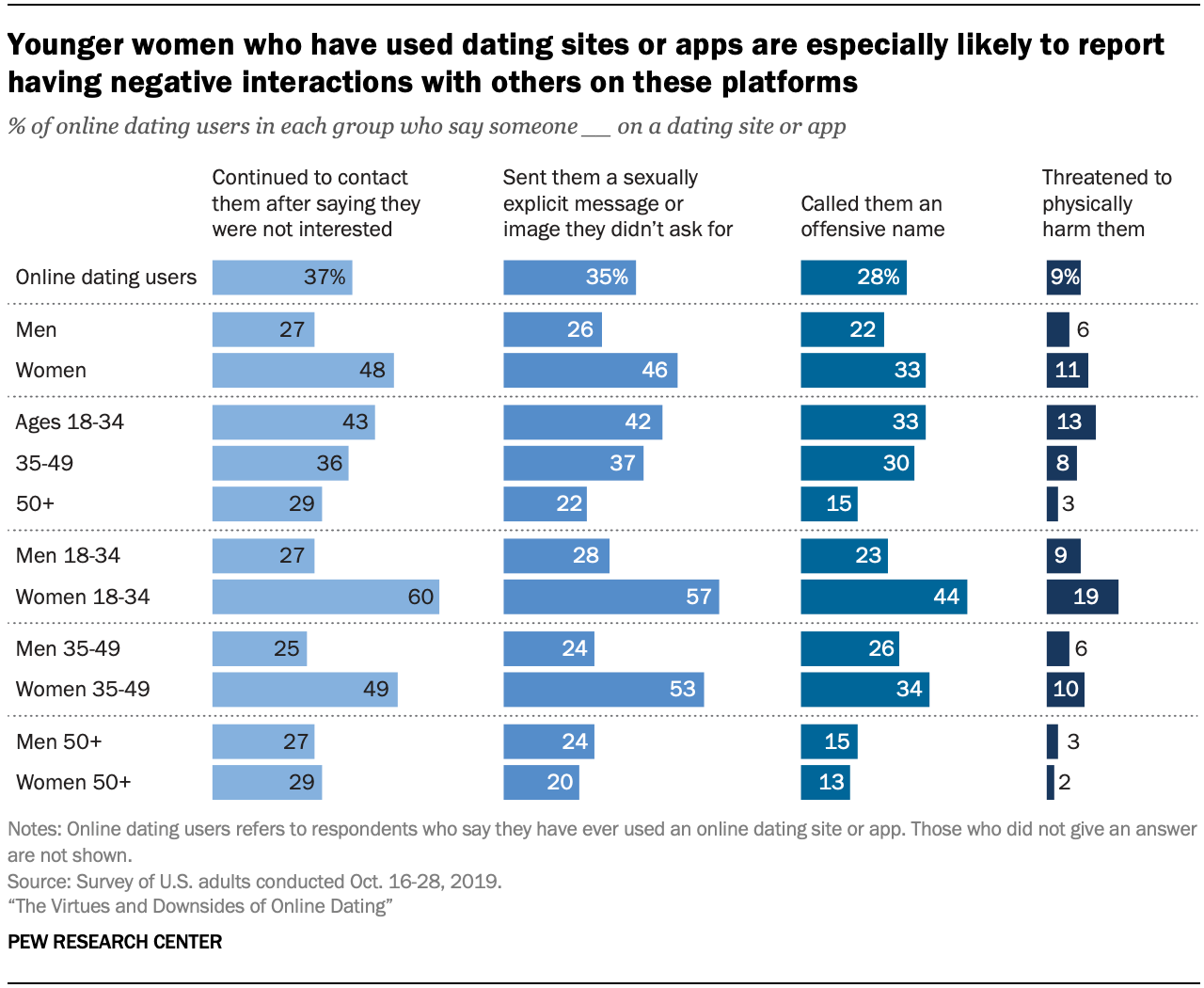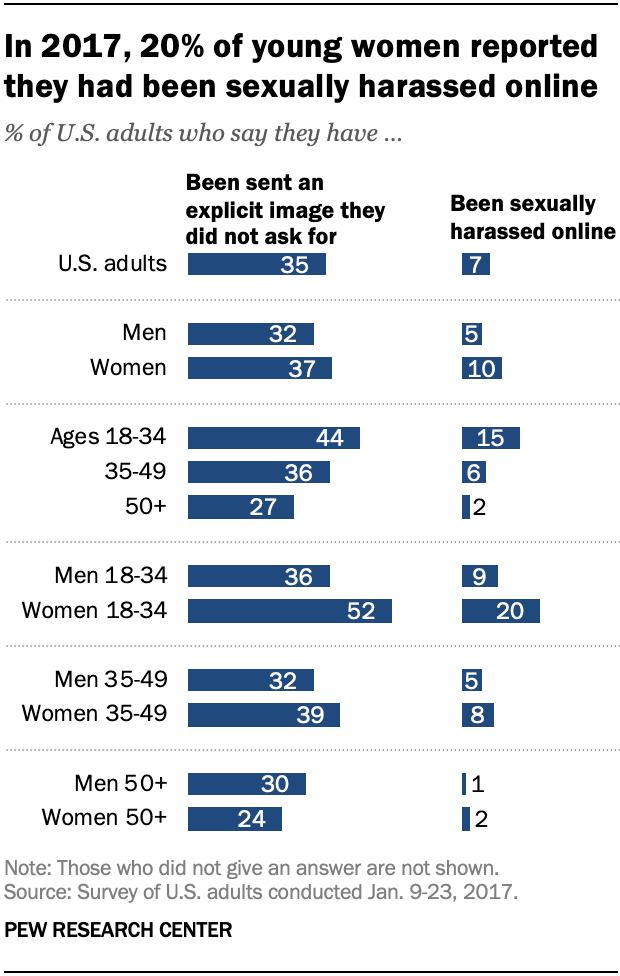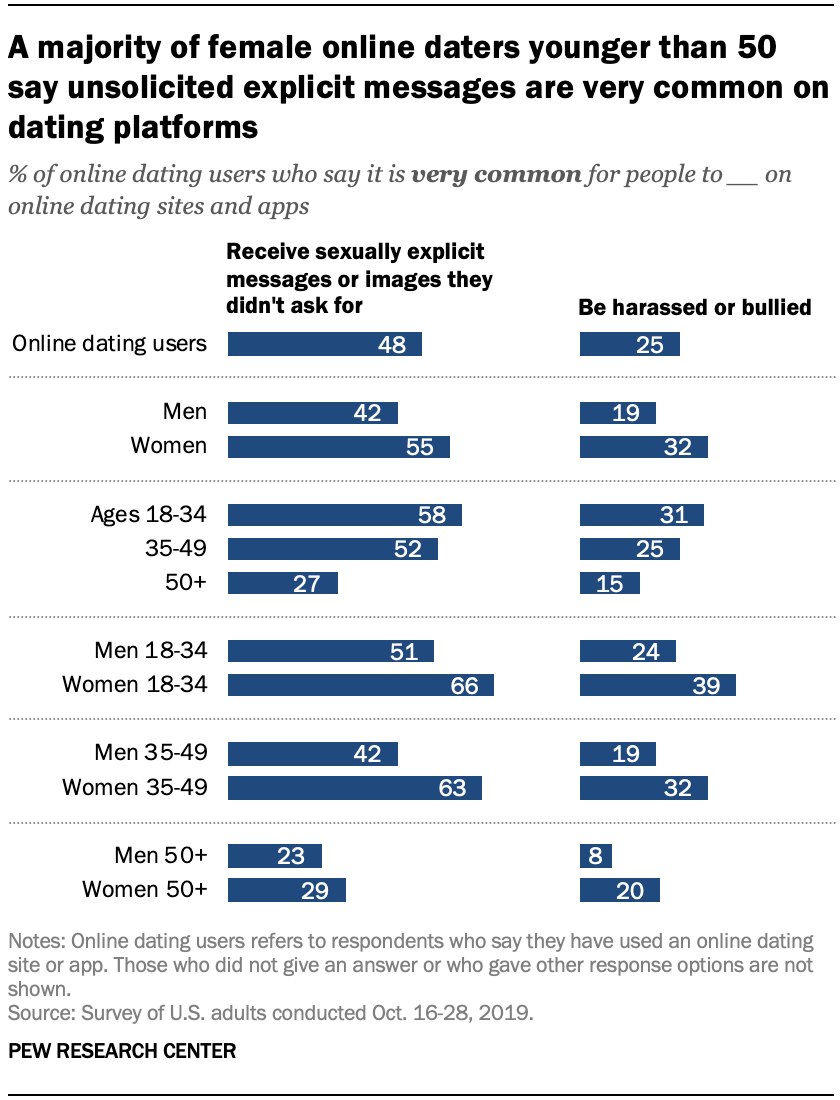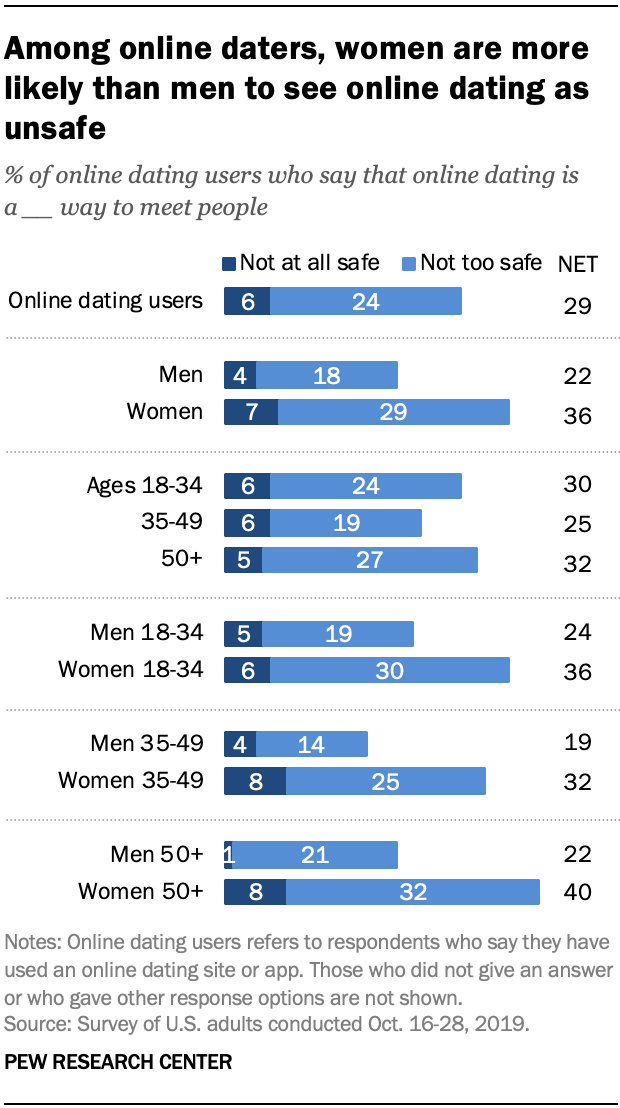
Online dating has grown in popularity, but many young women report experiencing some form of harassment on these platforms, according to a recent Pew Research Center survey.
Six-in-ten women under the age of 35 who have used online dating sites or apps say someone continued to contact them after they said they were not interested, compared with 27% of men in this age range. Younger female users are also about twice as likely as their male counterparts to say someone on a dating site or app has called them an offensive name (44% vs. 23%) or threatened to physically harm them (19% vs. 9%).
Pew Research Center has a history of studying online harassment. This particular report focuses on online harassment via online dating sites and apps in America, while considering the larger context of harassment in other online spaces. These findings are based on three surveys. The first is a study of online dating conducted Oct. 16 to 28, 2019, among 4,860 U.S. adults. These include those who took part as members of the Center’s American Trends Panel (ATP), an online survey panel that is recruited through national, random sampling of residential addresses. Additional respondents who indicated that they identify as lesbian, gay or bisexual (LGB) were drawn from the Ipsos KnowledgePanel, an online survey panel that is recruited through national, random sampling. The second study was about online harassment conducted Jan. 9 to 23, 2017, among 4,248 U.S. adults; and the third was a study of teens’ experiences with online harassment conducted March 7 to April 10, 2018, among 743 U.S. teens.
Recruiting ATP panelists by phone or mail ensures that nearly all U.S. adults have a chance of selection. This gives us confidence that any sample can represent the whole U.S. adult population (see our Methods 101 explainer on random sampling). To further ensure that each ATP survey reflects a balanced cross-section of the nation, the data are weighted to match the U.S. adult population by gender, race, ethnicity, partisan affiliation, education and other categories.
To learn more about the methods used for each of these studies, see the online dating survey’s methodology, the online harassment survey’s methodology or the teen survey’s methodology. Here are the questions used for this report, along with responses.
 Other encounters that young women describe are more overtly sexual: 57% of female online dating users ages 18 to 34 say someone has sent them a sexually explicit message or image they did not ask for. This compares with 28% among male users in the same age range. (In this analysis, online dating users are the 30% of U.S. adults who answered yes to the following question: “Have you ever used an online dating site or dating app?”)
Other encounters that young women describe are more overtly sexual: 57% of female online dating users ages 18 to 34 say someone has sent them a sexually explicit message or image they did not ask for. This compares with 28% among male users in the same age range. (In this analysis, online dating users are the 30% of U.S. adults who answered yes to the following question: “Have you ever used an online dating site or dating app?”)
These findings come at a time when online dating companies are deploying new tools to help combat harassment on their platforms – from using artificial intelligence to providing in-app features to report abusive behaviors. Still, some critics say these measures don’t go far enough.
A broader problem
Previous Pew Research Center studies have shown that these patterns are not confined to dating sites or apps: Young women are often the target of this type of digital abuse more broadly.
 A 2017 Center survey that used somewhat different measures of online harassment found that 45% of men and 39% of women have experienced some form of online harassment; however, women were more likely to encounter more sexualized forms of harassment. For example, women ages 18 to 34 were twice as likely as men in this age range to say they had been sexually harassed online (20% vs. 9%).
A 2017 Center survey that used somewhat different measures of online harassment found that 45% of men and 39% of women have experienced some form of online harassment; however, women were more likely to encounter more sexualized forms of harassment. For example, women ages 18 to 34 were twice as likely as men in this age range to say they had been sexually harassed online (20% vs. 9%).
The same survey found that 52% of women ages 18 to 34 reported receiving an explicit image they didn’t ask for, compared with 36% of their male counterparts.
In addition, women who had been harassed online were more likely than men to say they were targeted because of their gender (29% vs. 11%). This difference was most pronounced among those ages 35 to 49, with women about five times as likely as men to say this treatment was due to their gender (29% vs. 6%).
For women of all ages, the aftermath of online harassment is also more acutely felt than it is by men. In the 2017 survey, 36% of women who had experienced any type of online harassment described their most recent incident as either extremely or very upsetting. Among men, 16% described their most recent incident that way.
These issues don’t just affect adults. Teens also report being recipients of unwanted messages online, according to a separate Center survey conducted in 2018. In that survey, roughly a third of teen girls ages 15 to 17 said they had received sexually explicit images they didn’t ask for, again higher than the share among boys in this age range (as well as younger teens).

Gender differences in perceived harassment on dating sites
Men and women who have used online dating sites and apps hold somewhat differing views about how widespread online harassment is on these platforms, according to the most recent survey. For example, while 32% of female users say people being harassed or bullied is a very common occurrence on online dating platforms, that share falls to 19% among male users. These gender differences persist across all age ranges.
 Similarly, women who have used online dating platforms are more likely than men to say it is very common for people to receive sexually explicit messages or images they didn’t ask for (55% vs. 42%). This gender gap is more pronounced among online daters under the age of 50 than among those 50 and older.
Similarly, women who have used online dating platforms are more likely than men to say it is very common for people to receive sexually explicit messages or images they didn’t ask for (55% vs. 42%). This gender gap is more pronounced among online daters under the age of 50 than among those 50 and older.
Among those who have used an online dating platform – as well as among Americans overall – women are less likely than men to view meeting someone through a dating site or app as safe. Around a third of women who have online dated (36%) believe these platforms are not too or not at all safe for meeting people, compared with 22% of men. Still, majorities of online daters view these platforms as a safe way to meet others.
Note: Here are the questions used for this report, along with responses, and the methodology for the most recent survey cited.



